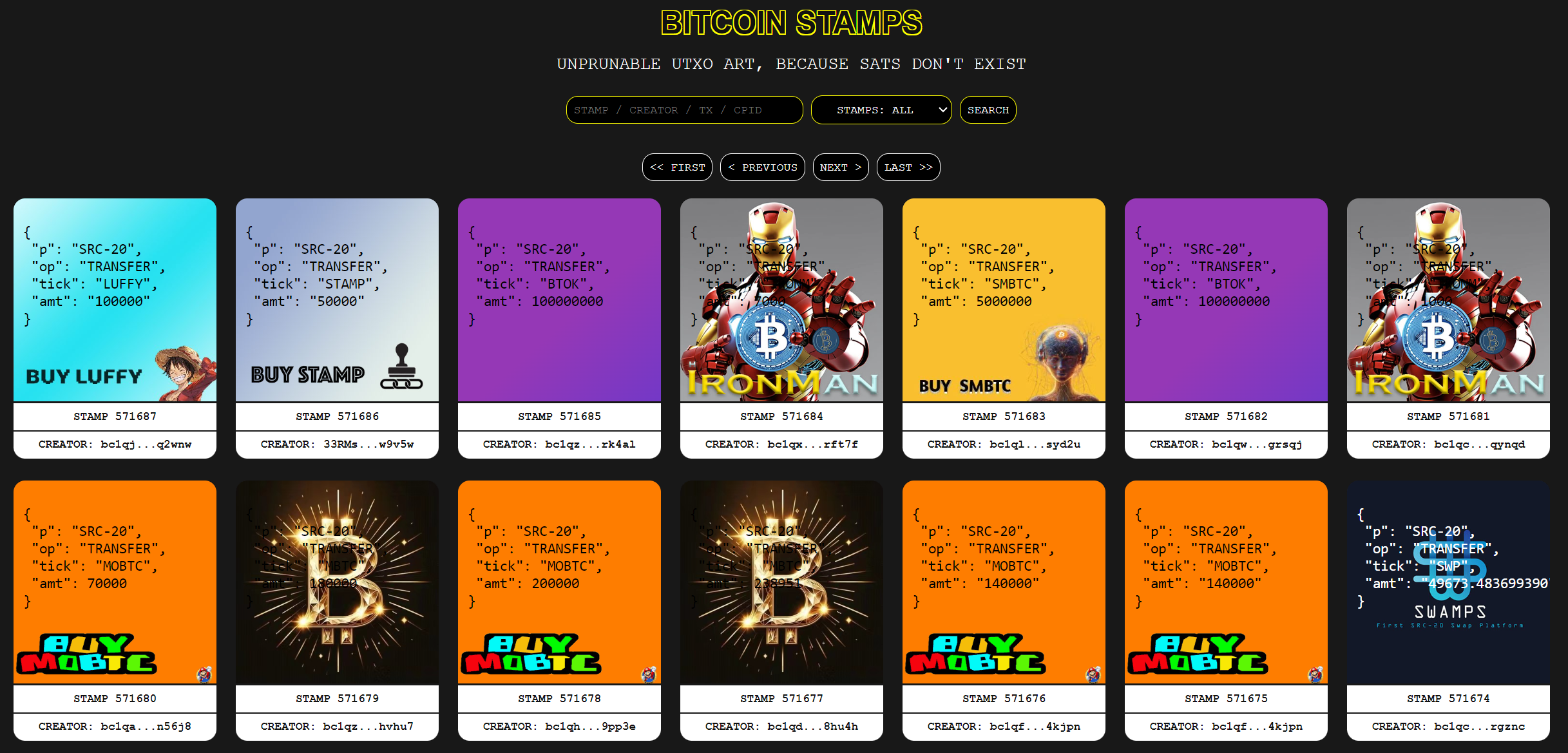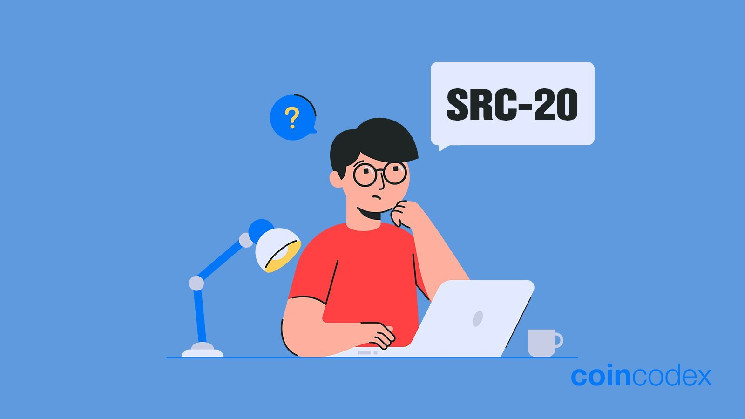You might have heard about SRC-20 tokens (often referred to as SRC 20 or SRC20 tokens) , a new digital asset on the Bitcoin blockchain. Essentially, SRC-20 enables the direct embedding of data within Bitcoin transactions. This ensures immutability and permanence.
But what exactly do SRC-20 tokens offer, and how do they fit into the broader Bitcoin ecosystem? They’re relevant for supporting various image formats and they contribute to the digital collectibles market. Let’s just say, SRC-20 tokens are gaining popularity, and this article will explore why.
Key highlights:
- SRC-20 tokens are a new digital asset on the Bitcoin blockchain, enabling data embedding in transactions for immutability and permanence.
- SRC-20 tokens utilize Bitcoin Stamps technology to store data in unspent transaction outputs, limiting images to 24×24 pixels in size.
- With over 260,000 tokens minted and a market capitalization exceeding $100 million, SRC-20 tokens are gaining significant traction.
- The token standard expands Bitcoin’s use beyond financial transactions, enabling the secure creation and trade of digital collectibles and NFTs.
What are SRC-20 tokens
SRC-20 tokens represent a new breed of digital assets on the Bitcoin blockchain. They allow users to embed data directly into transactions and leverage a cutting-edge protocol for immutability and longevity. These tokens join the ranks of Ethereum’s ERC-20 tokens in terms of their use in decentralized applications, but with a twist specific to Bitcoin.
SRC-20 tokens utilize the Bitcoin Stamps technology to store data in unspent transaction outputs (UTXOs).
In essence, SRC-20 tokens are fungible tokens that can store a variety of image types including JPG, SVG, GIF, and PNG, though they’re limited to 24×24 pixels in size.
This token standard has been gaining traction, with over 260,000 tokens minted so far. Also, their market capitalization has exceeded $100 million, which shows huge community engagement.
These advancements hold a lot of promise for creating digital assets securely within the Bitcoin ecosystem.
What are Bitcoin Stamps
Bitcoin Stamps embody a new method for embedding images directly onto the Bitcoin blockchain. The SRC20 stamp protocol is the underlying technology that SRC-20 tokens utilize. This technology allows users to mint non-fungible tokens (NFTs) and expand the use cases of Bitcoin, in the sense that it allows incorporating unique digital images into the blockchain.
Each Stamp is identified by a unique transaction number and contains a valid image string in base64 format, a component that’s crucial for its legitimacy. This base64 encoding makes sure that the Stamp is safely encoded and easily recoverable from the transaction data.
When you create a Bitcoin Stamp, the metadata for the original image is securely stored in the UTXO, which prevents data pruning. This makes Stamps truly permanent digital artifacts.
Bitcoin Stamps mostly focus on artistic representation and collectibles, and are therefore distinguishable from other asset types. The technology offers users an engaging way to create, buy, and trade unique digital art within the Bitcoin ecosystem.

You can explore existing Bitcoin Stamps on stampchain.io.
Bitcoin Stamps VS Bitcoin Ordinals
When looking at the differences between Bitcoin Stamps and Bitcoin Ordinals, one key distinction stands out – the permanent embedding of metadata in UTXOs for Stamps, as opposed to the potentially prunable data inscriptions on satoshis for Ordinals.
These differences imply very different use cases and levels of reliability of data storage.
Here are some key differences to consider:
- Data Permanence: Bitcoin Stamps store data directly in UTXOs, which means it remains immutable. Ordinals, on the other hand, can have their data pruned due to their reliance on witness data.
- Image Size Limitations: Stamps have a maximum size of 24×24 pixels for image files, while Ordinals can handle up to 4 MB.
-
Use Cases: Bitcoin Stamps are geared toward digital collectibles, art, and memorabilia. Ordinals focus on enhancing transaction granularity within the Bitcoin ecosystem.
Storage Methods: Stamps use the Bitcoin Stamps protocol, which emphasizes direct embedding into UTXOs. Ordinals, by contrast, write data in the Witness Field of a block.
How do SRC-20 tokens work
You store the data for SRC-20 tokens by converting images to a Base64 format. Then, you decode it within the description key of a Bitcoin transaction. This way, the storage on the blockchain stays permanent and immutable.
The process creates a unique, numerical identifier for each token, so that they’re indivisible.
Once encoded, these tokens are broadcast to the Bitcoin network for validation. The use of UTXOs as the storage method sets SRC-20 tokens apart from other standards, and it makes the data non-prunable, which means it stays on the blockchain.
In essence, it allows each token to be truly immutable and secure.
After they’re created, these tokens must meet specific criteria. Each stamp must be numerical and have a unique identifier.
How is SRC-20 significant in the Bitcoin Ecosystem
Frankly, as you dive deeper into the Bitcoin ecosystem, it’s clear that SRC-20 tokens have significantly broadened the use cases of this blockchain and made it more competitive with other decentralized platforms.
The SRC-20 token standard has expanded the capabilities of the Bitcoin blockchain. What used to be used purely for financial transactions has now gained new use cases. Four key impacts include:
- Better Security: By storing data in UTXOs, SRC-20 tokens are secure, immutable, and not prunable. This ensures the long-term preservation of data and asset information
- Increased Use Cases: SRC- 20 standard allows for the creation of fungible and non-fungible tokens directly on the blockchain. The has opened up new creative and trading avenues digital collectibles and NFTs on Bitcoin, similar to Ethereum’s ERC-20 tokens.
- Independence from Currency Functions: SRC-20 tokens operate independently of Bitcoin’s main currency function, which shows the blockchain’s potential for diverse decentralized applications.
How to use SRC-20 tokens
To leverage the versatility of SRC-20 tokens, you begin by understanding the essential steps for creating and managing these innovative assets within the Bitcoin ecosystem.
- Since SRC-20 tokens are created using the Stamps protocol, you need to convert images into Base64 format, so that data is inscribed onto Bitcoin’s blockchain.
- You then require a compatible Bitcoin wallet to facilitate peer-to-peer transactions and independent storage of the tokens.
- When minting an SRC-20 token, you generate a Bitcoin receiving address and follow the specified minting process. This process includes selecting ticker symbols and confirming payment for the desired token quantities.
Transaction fees for SRC-20 tokens are paid in Bitcoin, so the integration within the ecosystem is seamless.
SRC-20 VS BRC-20: Comparison
When comparing SRC-20 and BRC-20, you’ll notice that each has its own unique features that impact how data is embedded and managed within the Bitcoin ecosystem.
SRC-20 tokens leverage the Bitcoin Stamps protocol for immutable data storage on UTXOs. It’s worth noting that the Stamp protocol has its own token, STAMP, which is used for trading, peer-to-peer (P2P) transactions, and memorial inscriptions on the Bitcoin blockchain.
BRC-20 tokens, on the other hand, utilize Bitcoin Ordinals for data that can be modified and potentially pruned. The Ordinal protocol’s native token is ORDI, and it fulfills a similar function as STAMP.
Here are the key differences between SRC-20 and BRC-20:
-
Immutability: SRC-20 tokens can’t be altered after creation, whereas BRC-20 tokens’ data can be modified as needed.
Data Size: SRC-20 tokens allow for larger data sizes, impacting transaction costs, while BRC-20 tokens benefit from restricted size limits that provide more predictable fees.
Integration: SRC-20 operates independently of Bitcoin coin transactions but facilitates parallel functionality. BRC-20 can alter underlying data and influence how token interactions are executed.
Adoption: BRC-20 tokens currently have an edge in adoption and market presence simply due to their established integration across exchanges. SRC-20 tokens are in the early development stages with growing interest.
The bottom line
SRC-20 tokens are embedded directly in Bitcoin transactions, and they ensure immutability and facilitate fungible and non-fungible token creation. They use the Bitcoin Stamps protocol and store image data securely in UTXOs, which supports supporting formats like JPG, GIF, PNG, and SVG.
Their reliance on UTXOs for storage makes them secure and irreversible. This innovation fundamentally expands Bitcoin’s use beyond simple transactions. It allows the creation and trade of unique digital assets and collectibles, similar to Ethereum’s ERC-20 tokens. As SRC-20 tokens gain popularity, they significantly enhance the Bitcoin ecosystem’s potential.
Who knows, maybe protocols like SRC-20 and BRC-20 and projects like Stacks will be instrumental in building a trhving DeFi ecosystem on Bitcoin that could rival Ethereum and other Proof-of-Stake (PoS) chains. If that happens the price of Bitcoin actually could touch the 7-figure mark in the far future.


